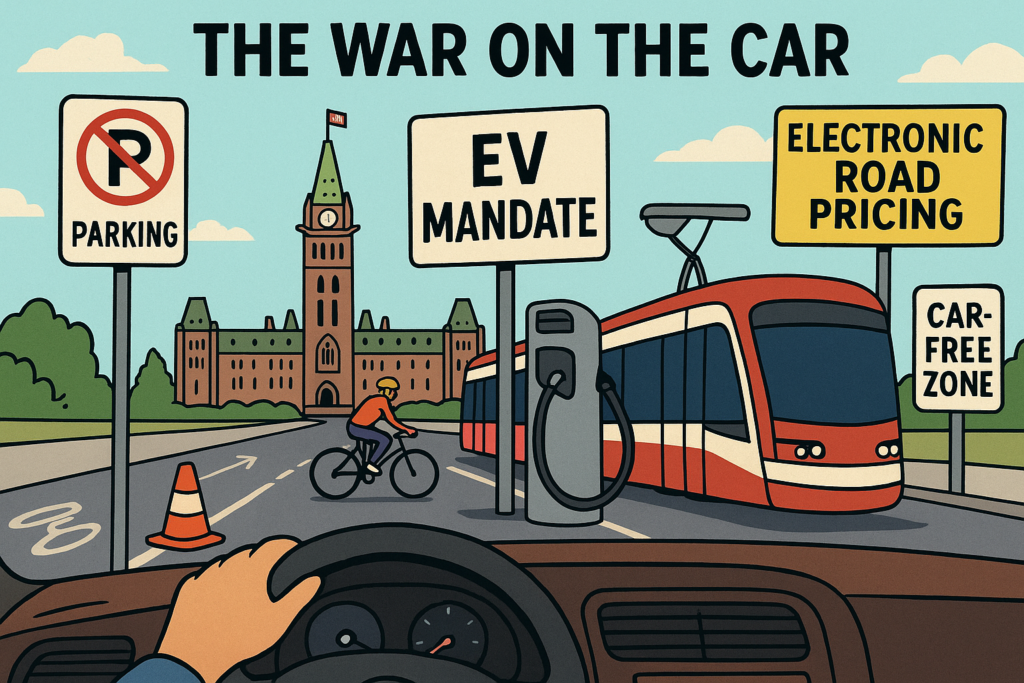In part one of this blog post, we looked at how municipalities have spent decades waging their quiet war on the car. Now, the big guns from higher levels of government are actively involved in the WOTC, through a most ingenious Net Zero policy: Electric Vehicle (EV) mandates.
What do EVs have to do with the WOTC, you ask? After all, EVs are still “cars,” aren’t they? The answer can be found in the powerful economic principle of the law of supply and demand.
For decades, the WOTC has focused on reducing the demand for cars by irritating drivers and making driving inconvenient or unpleasant – using the same propaganda playbook as outlined in part one of this blogpost, where we explored how municipalities have tried to shame people for using and enjoying their cars.
The demand for cars kept increasing, though.
In the 1970s, the shaming got underway in earnest. The Green Left prophesied about the impending global shortage of gasoline (derived from oil, of which we were allegedly running short). These predictions were, of course, wrong and by the 1980s, we instead experienced an oil glut. Some then complained about leaded gasoline, but unleaded gasoline and improved technology took care of that concern.
Then they tried to guilt us by saying that the internal combustion engine (ICE) automobile – even with unleaded gasoline – was still destroying the planet, and so they invented the fiction that electric vehicles were cleaner by magnitudes. But that ignores a simple truth: most of the world’s electricity still comes from hydrocarbons – oil, gas, and coal – so EVs are hardly “emission-free.”
The population continued to increase and so did the demand for more cars. In Canada, the number of registered vehicles has more than tripled since the 1960s from 8 million to 26 million in 2023 – 3.4% of which are zero-emission vehicles.
Some upper-middle-class virtue-signallers did eagerly snap up the taxpayer-funded “rebate” subsidies for their more expensive EVs before they ran out (to make the virtue-signalling a little less painful, but also, well, a little less virtuous). Minus incentives, however, few people were swayed by the pure and simple temptation to virtue-signal through EV ownership.
In other words, everyday Canadians haven’t been buying-in – not into the propaganda, and not into EVs.
While governments here in Canada, the USA, and abroad have been spending billions to subsidize the manufacture of these EVs, taxpayer-subsidized efforts still haven’t been able to get the price down low enough to attract working families to buy them. Nor have they been able to guilt citizens into simply paying more for an EV so they can show their neighbours just how good and “virtuous” they truly are!
So the Green Left and their partners in government have recently shifted to the supply side of the equation instead.
Attempts to guilt or pressure drivers into buying electric vehicles (EVs) have failed. Demand for ICE vehicles remains strong, so lawmakers and the Green Left have shifted tactics, now aiming to reduce the overall supply of cars instead.
The federal Liberal government remains fixated on its Net Zero agenda, clinging to the Trudeau-era policy that, by 2035, 100% of vehicles sold in Canada must be electric. Even though Prime Minister Carney announced in early September a supposed “review” of the EV mandate and a temporary pause on the 20%-by-2026 sales target, make no mistake, the Carney Liberal government is still fully committed to the 60%-by-2030 and 100%-by-2035 targets.
The Liberals’ aggressive plan to force Canadians into EVs through mandates is more than mere virtue-signalling, it’s fundamentally unachievable. There is simply no realistic scenario – by 2026, 2030, 2050, or ever – where enough EVs could be built to meet the current and projected demand for automobiles in North America.
The Liberal government and their Green Left allies in municipalities across Canada know this perfectly well. But here’s the twist: it’s not a flaw in the plan. It is the plan.
By making EVs scarce and pushing gas-powered cars off the market, they’re creating a future with fewer cars, fewer drivers, and less freedom of movement.
Maybe that’s been the goal all along.

